Abstract
AIM--To investigate overexpression of c-erbB2, expression of the p53 protein product and proliferation rates in benign breast lesions with specific reference to apocrine adenosis. METHODS--Twenty one cases of apocrine adenosis were stained with monoclonal antibodies to p185, the protein product of the c-erbB2 oncogene, the protein product of the p53 tumour suppressor gene and to the cell cycle related protein Ki67. Three cases were associated with concomitant ductal carcinoma in situ of large cell type and two were associated with invasive tubular or cribriform carcinoma. RESULTS--Twelve (57.1%) cases showed membrane staining for c-erbB2 oncoprotein of apocrine cells within sclerosing adenosis and six (28.6%) had occasional p53 protein positive cells. One case not associated with carcinoma showed extensive staining of apocrine metaplasia outside the area of apocrine adenosis. The proliferation rate, as measured by Ki67 staining, was increased in some of the lesions and all lesions showed at least some of the cells to be in the cell cycle. CONCLUSIONS--The expression of abnormal oncogene products and increased proliferation in some of these apocrine lesions questions the supposed degenerative nature of the atypia seen in such cases and suggests that there may be an association between these lesions and large cell ductal carcinoma in situ and hence invasive carcinoma.
Full text
PDF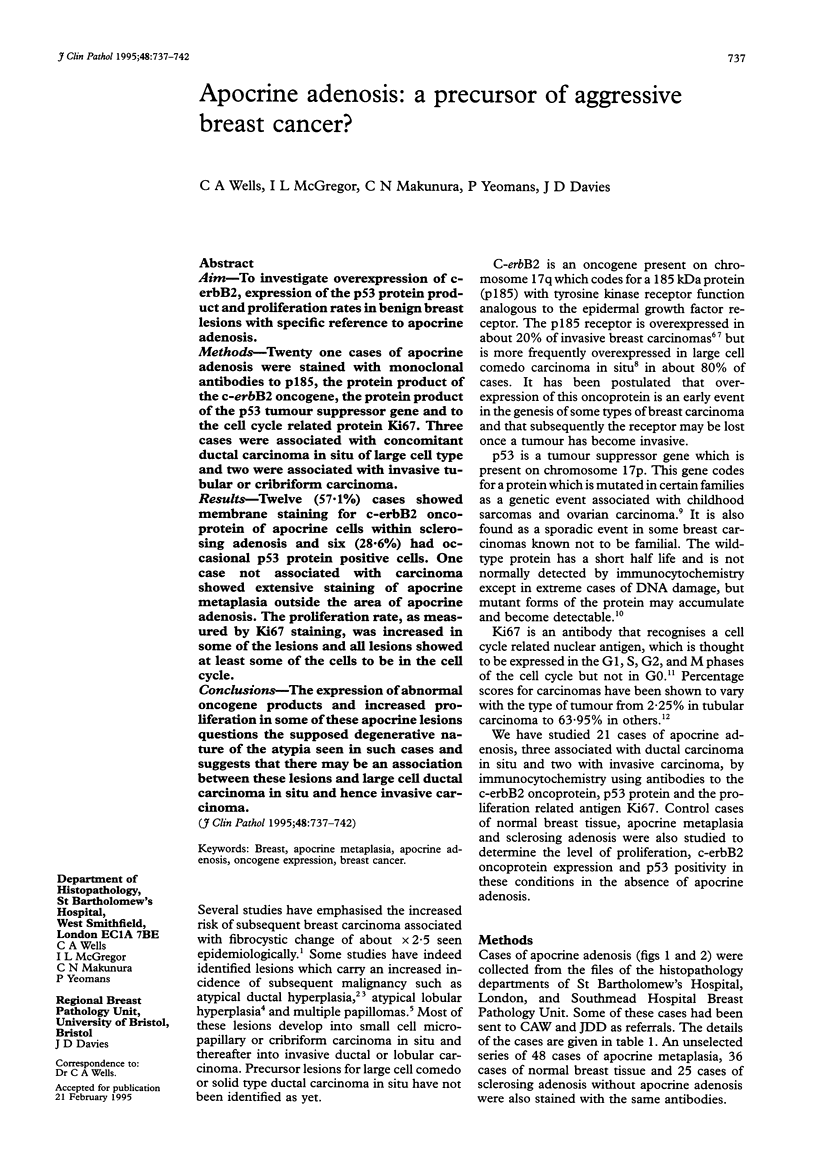
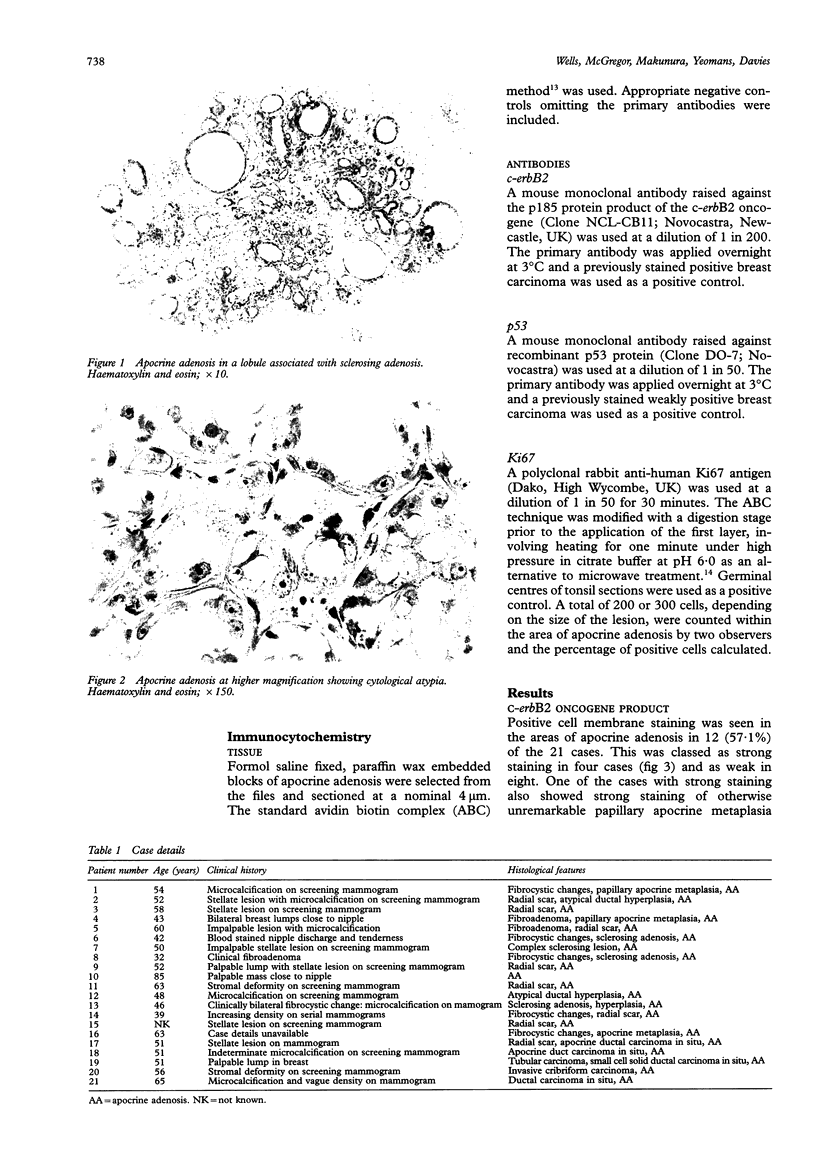
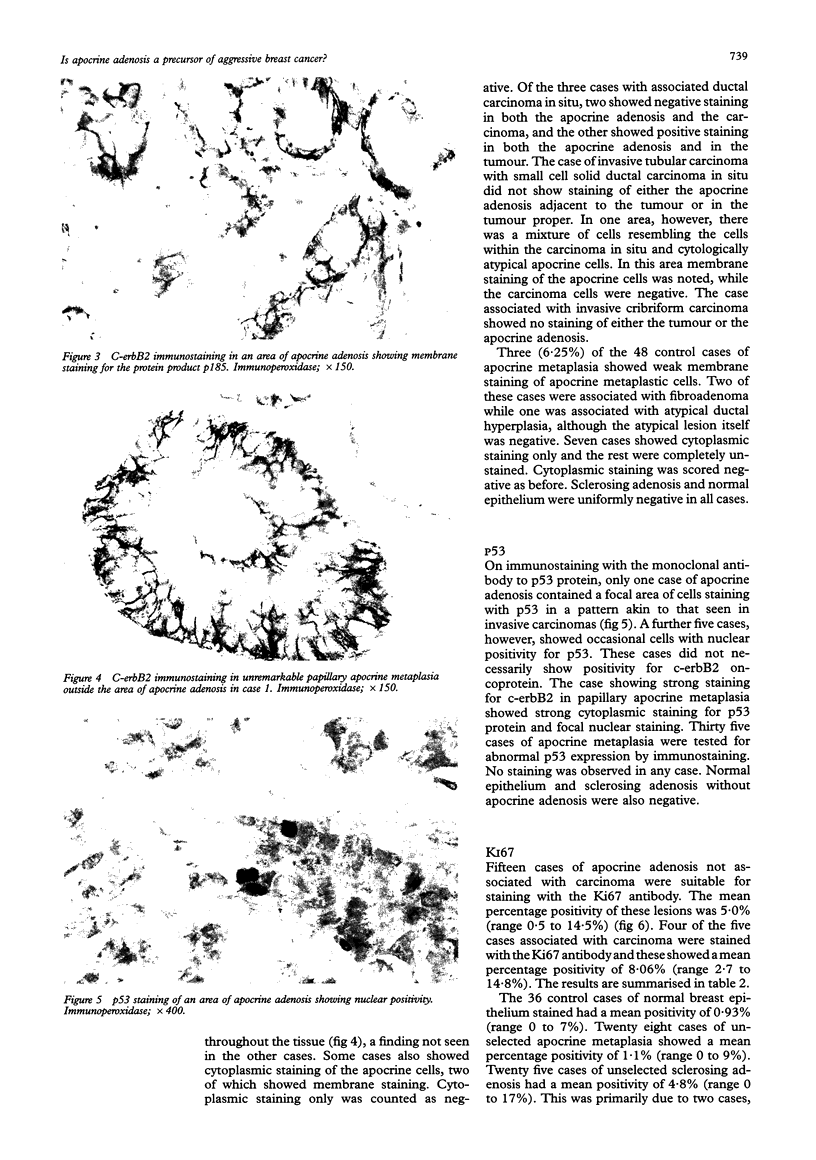
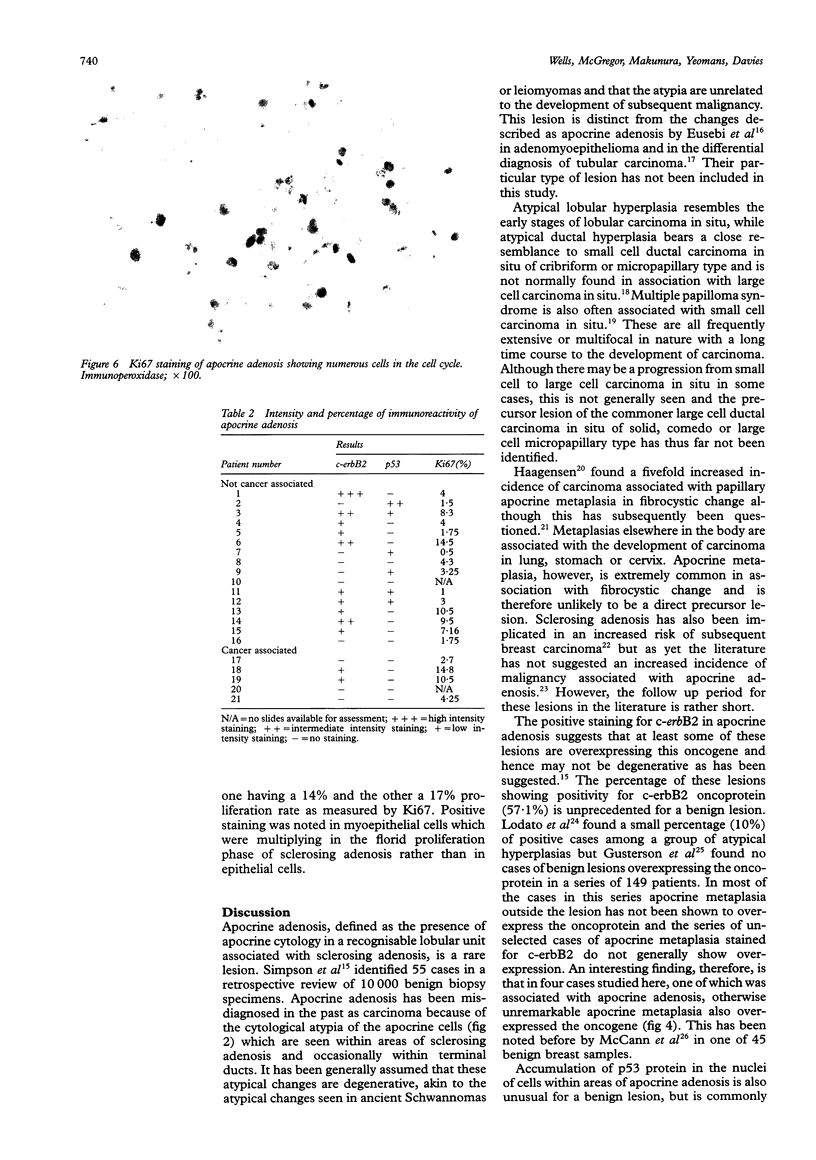
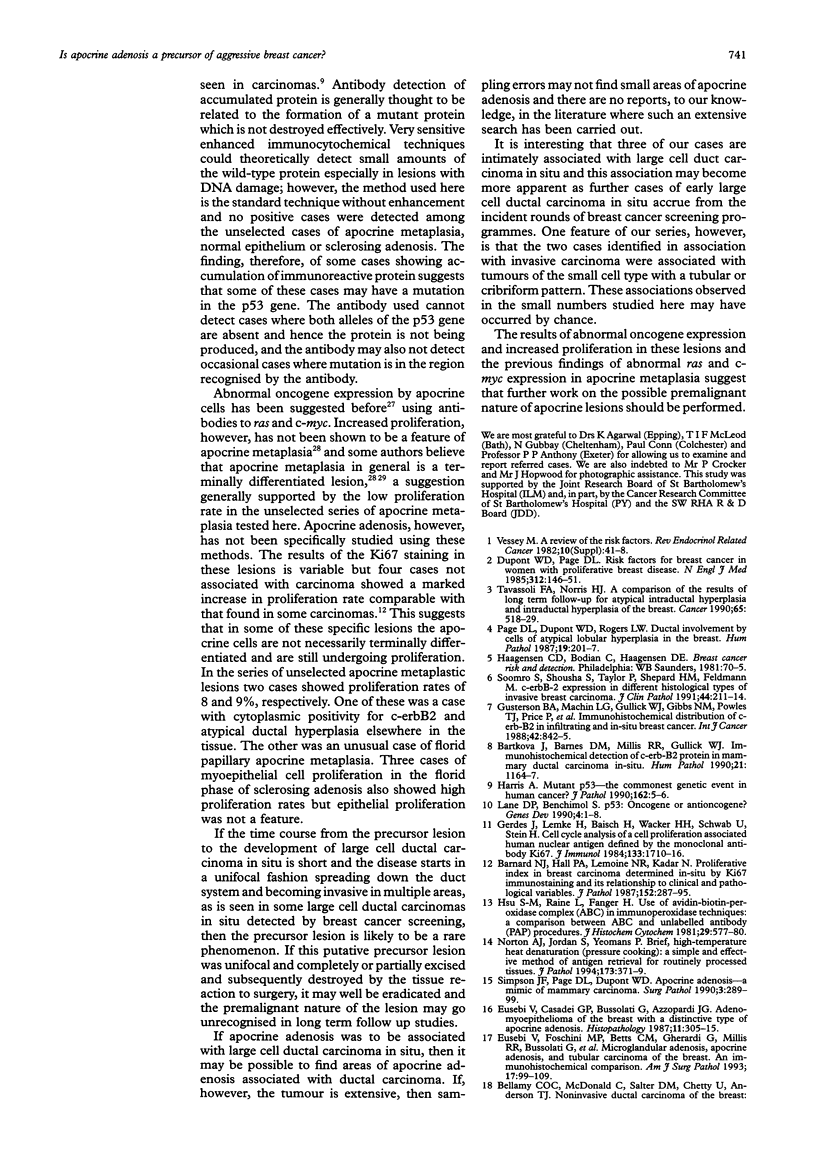
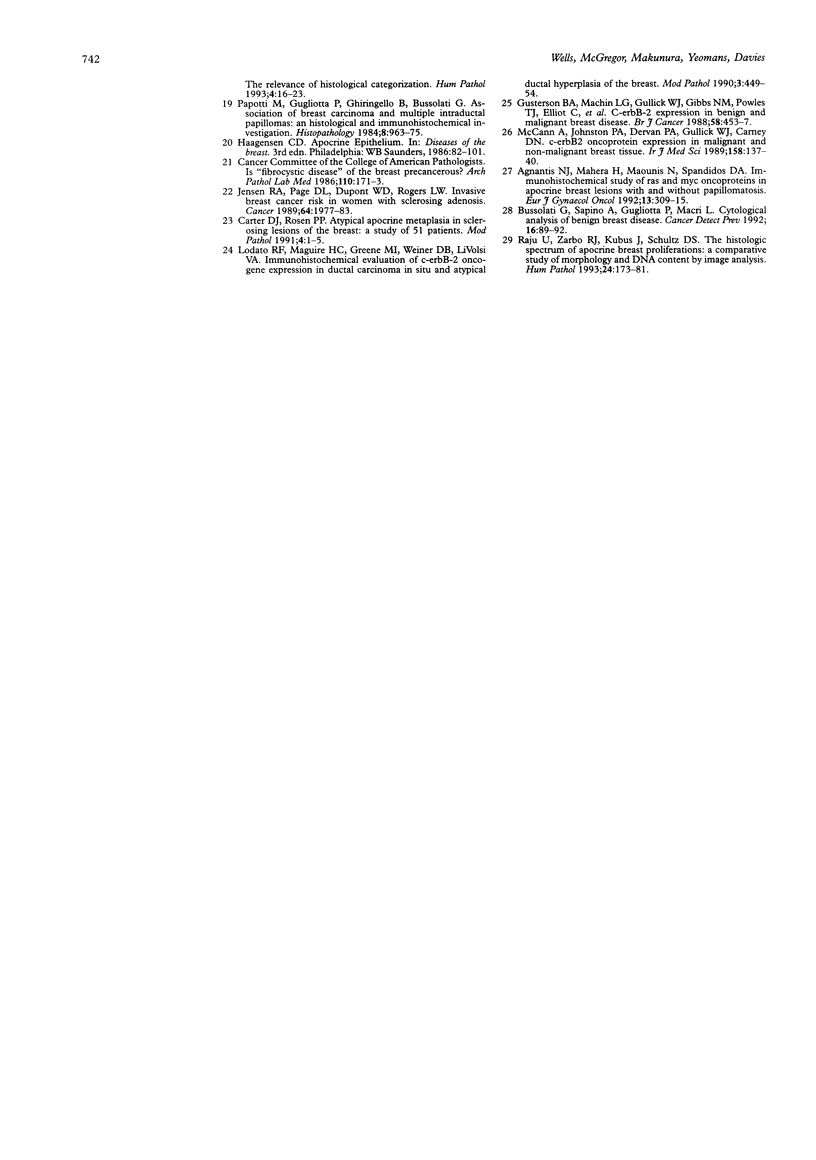
Images in this article
Selected References
These references are in PubMed. This may not be the complete list of references from this article.
- Agnantis N. J., Mahera H., Maounis N., Spandidos D. A. Immunohistochemical study of ras and myc oncoproteins in apocrine breast lesions with and without papillomatosis. Eur J Gynaecol Oncol. 1992;13(4):309–315. [PubMed] [Google Scholar]
- Barnard N. J., Hall P. A., Lemoine N. R., Kadar N. Proliferative index in breast carcinoma determined in situ by Ki67 immunostaining and its relationship to clinical and pathological variables. J Pathol. 1987 Aug;152(4):287–295. doi: 10.1002/path.1711520407. [DOI] [PubMed] [Google Scholar]
- Bartkova J., Barnes D. M., Millis R. R., Gullick W. J. Immunohistochemical demonstration of c-erbB-2 protein in mammary ductal carcinoma in situ. Hum Pathol. 1990 Nov;21(11):1164–1167. doi: 10.1016/0046-8177(90)90154-w. [DOI] [PubMed] [Google Scholar]
- Bellamy C. O., McDonald C., Salter D. M., Chetty U., Anderson T. J. Noninvasive ductal carcinoma of the breast: the relevance of histologic categorization. Hum Pathol. 1993 Jan;24(1):16–23. doi: 10.1016/0046-8177(93)90057-n. [DOI] [PubMed] [Google Scholar]
- Bussolati G., Sapino A., Gugliotta P., Macrì L. Cytological analysis of benign breast disease. Cancer Detect Prev. 1992;16(2):89–92. [PubMed] [Google Scholar]
- Carter D. J., Rosen P. P. Atypical apocrine metaplasia in sclerosing lesions of the breast: a study of 51 patients. Mod Pathol. 1991 Jan;4(1):1–5. [PubMed] [Google Scholar]
- Dupont W. D., Page D. L. Risk factors for breast cancer in women with proliferative breast disease. N Engl J Med. 1985 Jan 17;312(3):146–151. doi: 10.1056/NEJM198501173120303. [DOI] [PubMed] [Google Scholar]
- Eusebi V., Casadei G. P., Bussolati G., Azzopardi J. G. Adenomyoepithelioma of the breast with a distinctive type of apocrine adenosis. Histopathology. 1987 Mar;11(3):305–315. doi: 10.1111/j.1365-2559.1987.tb02635.x. [DOI] [PubMed] [Google Scholar]
- Eusebi V., Foschini M. P., Betts C. M., Gherardi G., Millis R. R., Bussolati G., Azzopardi J. G. Microglandular adenosis, apocrine adenosis, and tubular carcinoma of the breast. An immunohistochemical comparison. Am J Surg Pathol. 1993 Feb;17(2):99–109. doi: 10.1097/00000478-199302000-00001. [DOI] [PubMed] [Google Scholar]
- Gerdes J., Lemke H., Baisch H., Wacker H. H., Schwab U., Stein H. Cell cycle analysis of a cell proliferation-associated human nuclear antigen defined by the monoclonal antibody Ki-67. J Immunol. 1984 Oct;133(4):1710–1715. [PubMed] [Google Scholar]
- Gusterson B. A., Machin L. G., Gullick W. J., Gibbs N. M., Powles T. J., Elliott C., Ashley S., Monaghan P., Harrison S. c-erbB-2 expression in benign and malignant breast disease. Br J Cancer. 1988 Oct;58(4):453–457. doi: 10.1038/bjc.1988.239. [DOI] [PMC free article] [PubMed] [Google Scholar]
- Gusterson B. A., Machin L. G., Gullick W. J., Gibbs N. M., Powles T. J., Price P., McKinna A., Harrison S. Immunohistochemical distribution of c-erbB-2 in infiltrating and in situ breast cancer. Int J Cancer. 1988 Dec 15;42(6):842–845. doi: 10.1002/ijc.2910420608. [DOI] [PubMed] [Google Scholar]
- Harris A. L. Mutant p53--the commonest genetic abnormality in human cancer? J Pathol. 1990 Sep;162(1):5–6. doi: 10.1002/path.1711620103. [DOI] [PubMed] [Google Scholar]
- Hsu S. M., Raine L., Fanger H. Use of avidin-biotin-peroxidase complex (ABC) in immunoperoxidase techniques: a comparison between ABC and unlabeled antibody (PAP) procedures. J Histochem Cytochem. 1981 Apr;29(4):577–580. doi: 10.1177/29.4.6166661. [DOI] [PubMed] [Google Scholar]
- Jensen R. A., Page D. L., Dupont W. D., Rogers L. W. Invasive breast cancer risk in women with sclerosing adenosis. Cancer. 1989 Nov 15;64(10):1977–1983. doi: 10.1002/1097-0142(19891115)64:10<1977::aid-cncr2820641002>3.0.co;2-n. [DOI] [PubMed] [Google Scholar]
- Lodato R. F., Maguire H. C., Jr, Greene M. I., Weiner D. B., LiVolsi V. A. Immunohistochemical evaluation of c-erbB-2 oncogene expression in ductal carcinoma in situ and atypical ductal hyperplasia of the breast. Mod Pathol. 1990 Jul;3(4):449–454. [PubMed] [Google Scholar]
- McCann A., Johnston P. A., Dervan P. A., Gullick W. J., Carney D. N. c-erB-2 oncoprotein expression in malignant and nonmalignant breast tissue. Ir J Med Sci. 1989 Jun;158(6):137–140. doi: 10.1007/BF02943053. [DOI] [PubMed] [Google Scholar]
- Norton A. J., Jordan S., Yeomans P. Brief, high-temperature heat denaturation (pressure cooking): a simple and effective method of antigen retrieval for routinely processed tissues. J Pathol. 1994 Aug;173(4):371–379. doi: 10.1002/path.1711730413. [DOI] [PubMed] [Google Scholar]
- Page D. L., Dupont W. D., Rogers L. W. Ductal involvement by cells of atypical lobular hyperplasia in the breast: a long-term follow-up study of cancer risk. Hum Pathol. 1988 Feb;19(2):201–207. doi: 10.1016/s0046-8177(88)80350-2. [DOI] [PubMed] [Google Scholar]
- Papotti M., Gugliotta P., Ghiringhello B., Bussolati G. Association of breast carcinoma and multiple intraductal papillomas: an histological and immunohistochemical investigation. Histopathology. 1984 Nov;8(6):963–975. doi: 10.1111/j.1365-2559.1984.tb02414.x. [DOI] [PubMed] [Google Scholar]
- Raju U., Zarbo R. J., Kubus J., Schultz D. S. The histologic spectrum of apocrine breast proliferations: a comparative study of morphology and DNA content by image analysis. Hum Pathol. 1993 Feb;24(2):173–181. doi: 10.1016/0046-8177(93)90297-t. [DOI] [PubMed] [Google Scholar]
- Tavassoli F. A., Norris H. J. A comparison of the results of long-term follow-up for atypical intraductal hyperplasia and intraductal hyperplasia of the breast. Cancer. 1990 Feb 1;65(3):518–529. doi: 10.1002/1097-0142(19900201)65:3<518::aid-cncr2820650324>3.0.co;2-o. [DOI] [PubMed] [Google Scholar]








